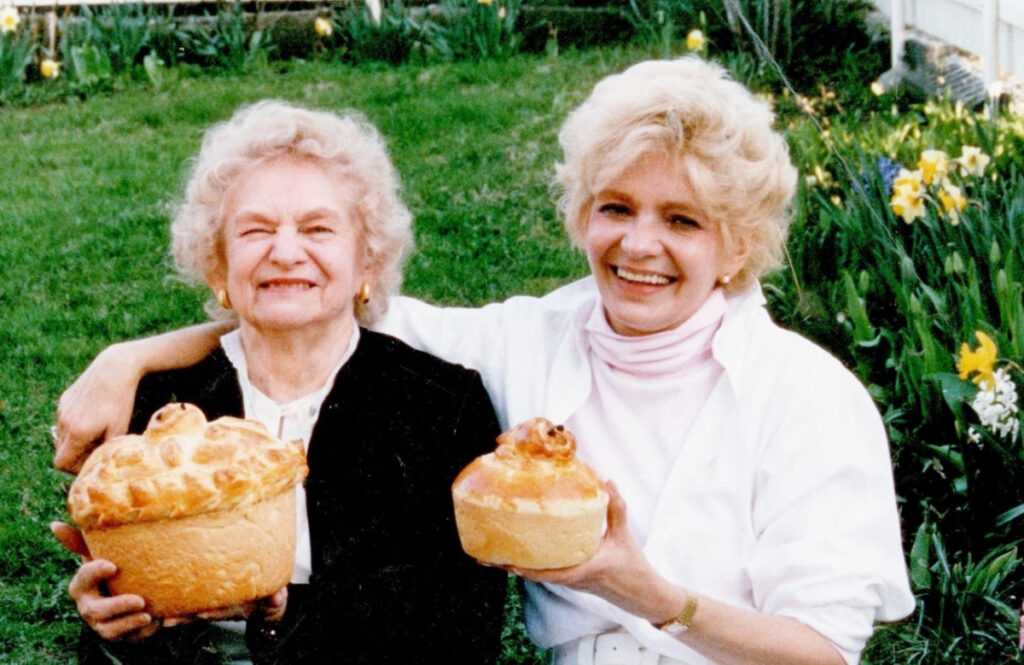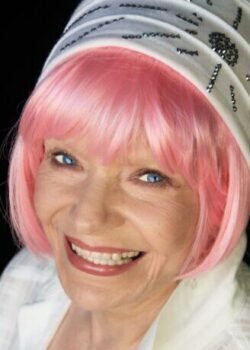I can’t pronounce it but I sure can remember it.
On Easter Sunday we usually greet someone by saying: Happy Easter! And the person usually responds: Happy Easter! Well, when I was a kid, on Easter Sunday my Czechoslovakian parents would say, Kristus vstal z mŕtvych (Christ has risen) and the other Slovak person would respond: Kristus skutočne vstal z mŕtvych (Christ has truly risen). These greetings were always said in booming voices, with each syllable an explosion crushing the air. And they sounded excited—like they were the apostles telling everyone the good news that Jesus had not only risen from the dead, he had TRULY risen.
Every year we always celebrated two Christmases and two Easters. That’s because Byzantine Slovaks adhere to the Julian calendar, while western Christians observe Holy Days according to the Gregorian calendar. This year Byzantine/Orthodox Easter is April 24 and we in the west celebrate Easter on April 17.
My mother’s Easter baking was beyond marvelous! (Well, maybe Frank’s cream puffs might beat hers out for the best in the world.) But I’m sure nobody baked a better Easter paska than my mom. It’s a special bread with braids and a little bird on top made of yeasted dough. She always made me a small version of paska to eat all by myself. (Visit https://www.thespruceeats.com/ukrainian-easter-bread-recipe-paska-1137468 for a Ukrainian paska recipe.)
On Easter Eve, Mom would also bake the ham, color the eggs, and cook the entire dinner for the following day. In the evening she’d put everything into a big basket, we’d all pile into the car, and drive to the church where we’d put the basket inside the church basement. Then everyone would walk around the outside perimeter of the church three times, go inside the church for a special service, and afterwards, follow the priest down into the basement where he would bless all the baskets. When we got back home, Mom would let me sneak a piece of paska before going to bed. The next morning I’d wake up to voices booming, Kristus vstal z mŕtvych! and Kristus skutočne vstal z mŕtvych! I’m darn sure God heard it.
Ellen Wood of Questa is an award-winning author as well as an artist using the name, Maruška. The website for her books and paintings is www.NorthernNewMexicoArtists.com/ellen-wood. Contact Ellen at
ellen@howtogrowyounger.com.
Translation by Teresa Dovalpage

No puedo pronunciarlo, pero lo recuerdo muy bien.
El Domingo de Pascua generalmente saludamos a los demás diciendoles: ¡Feliz Pascua Florida! Y la otra persona por lo regular responde: ¡Feliz Pascua Florida! Bueno, cuando era pequeña, el Domingo de Pascua mis padres checoslovacos decían Kristus vstal z mŕtvych (Cristo ha resucitado) y la otra persona eslovaca respondía Kristus skutočne vstal z mŕtvych (Cristo ha resucitado de verdad). Estos saludos siempre se decían con voces retumbantes y cada sílaba era como una explosión que resonaba en el aire.
Y sonaban emocionados—como si ellos mismos fueran los apóstoles dando a todos la buena nueva de que Jesús no solo había resucitado de entre los muertos, sino que VERDADERAMENTE había resucitado.
Todos los años siempre celebrábamos dos Navidades y dos Pascuas Floridas. La razón es que los eslovacos bizantinos se rigen por el calendario juliano y los cristianos occidentales observan las fiestas sagradas según el calendario gregoriano. Este año, la Pascua Florida bizantina/ortodoxa es el 24 de abril y en occidente celebramos la Pascua Florida el 17 de abril.
¡Mi madre era una magífica pastelera! (Bueno, tal vez las bolitas de crema de Frank superen a las de ella y sean las mejores del mundo). Pero estoy segura de que nadie horneaba una paska de Pascua Florida mejor que mi madre. La paska es un pan especial trenzado y con un pajarito encima hecho de masa con levadura. Siempre me hacía una versión pequeña para que me la comiese yo sola. (Consulte la página __ para ver una receta de paska ucraniana).
En la víspera de la Pascua Florida, mamá también horneaba el jamón, coloreaba los huevos y cocinaba la cena completa para el día siguiente. Por la noche, ponía todo en una canasta grande, todos nos apilábamos en el automóvil y conducíamos hasta la iglesia donde poníamos la canasta en el sótano de la iglesia. Luego, todos caminaban alrededor del perímetro exterior de la iglesia tres veces, entraban a la iglesia para un servicio especial y seguían al sacerdote hasta el sótano donde él bendecía todas las canastas. Cuando regresábamos a casa, mamá me dejaba agarrar un trozo de paska antes de acostarme y a la mañana siguiente me despertaba con las voces atronadoras Kristus vstal z mŕtvych y Kristus skutočne vstal z mŕtvych. Estoy absolutamente segura de que Dios las escuchaba.
Leyenda de la foto: Ellen Wood, también conocida como Maruška, y su madre sosteniendo paskas en 1987.
Traducido por Teresa Dovalpage
Author
-

Ellen Wood, born in 1936, is a prizewinning author, columnist and former management executive. After her youngest child began school, Ellen started an in-house ad agency and won 16 awards for annual report and advertising excellence, including 4 national awards. Five years after her mother died of Alzheimer’s, Ellen experienced early symptoms (she has the gene, APO-e4). At 68 she developed a program of mind/body/spirit techniques that proved so successful, she wrote and published “Think and Grow Young,” followed by “Joy! Joy! Joy!” (now retitled “The Secret Method for Growing Younger,” Volumes 1 and 2) and gave inspirational speeches. Since 2018 Ellen has been the ad agency for NorthStar Tire and Auto in Questa, NM. Ellen started painting in November of 2020, having dabbled at it in her 20s, and gave herself a new name: Maruška, her father’s middle name. She is overjoyed to be part of a big, loving, kindhearted family. You can find her paintings at www.northernnewmexicoartists.com/ellen-wood
View all posts


